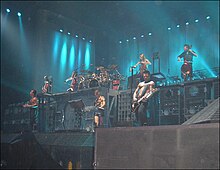This article needs additional citations for verification. (September 2020) |
Cello rock is a subgenre of rock music characterized by the use of cellos (as well as other bowed string instruments such as the violin and viola) as primary instruments, alongside or in place of more traditional rock instruments such as electric guitars, electric bass guitars, and drum sets.[1]
| Cello rock | |
|---|---|
| Stylistic origins | |
| Cultural origins | 1970s, United Kingdom |
| Other topics | |
| Baroque rock | |

Cellos, often in groups of three or more, are used to create a sound, rhythm, and texture similar to that of familiar rock music, but distinctly reshaped by the unique timbres and more traditional genres of the cello (in particular) and other string instruments used. Cellos and other stringed instruments are often amplified and/or modified electronically, and they are often played in a manner imitative of the sound of electric guitars. They are often combined with other elements typical of rock music such as rock-style vocals and drumming.[2][3]
Cello rock can trace its beginnings to the 1971 self-titled debut, known in the US as No Answer, by the Electric Light Orchestra, which featured rock songs arranged for cellos, and the subsequent tour consisted of a standard rock band augmented by four cellos. Jeff Lynne made a return with this format using three cellos for their 2001 comeback album Zoom and its subsequent but cancelled tour. Apocalyptica, which released their first album, Plays Metallica by Four Cellos, in 1996, originally used only cellos but has since added drums and bass and sometimes vocals. Starting in 2011, the duo 2Cellos began releasing covers of many rock standards, such as AC/DC's "Thunderstruck", and undertaking tours.
See also
editReferences
edit- ^ "Enter Cellomen". Archived from the original on 24 September 2015. Retrieved 12 February 2016.
- ^ "Музыка Cello rock". Last.fm. Retrieved 5 September 2020.
- ^ "Cello-rock duo Oak and Gorski combine symphonic, acoustic sounds for a signature brand in L.A." Daily Bruin. Retrieved 5 September 2020.